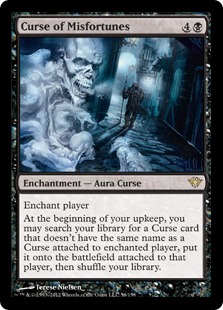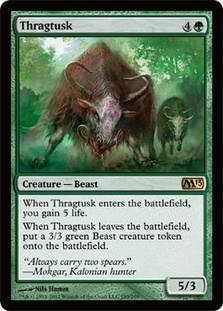Shoot. Hooey. Drat. Hogwash.
These are the curses my father inadvertently taught me in my youth. Here in Kentucky, good gentlemen don’t curse; instead, they invent curses (or at least I’m convinced they do). His mother says, "Well, smellll you!" instead of something worse, and my mother once suggested that we replace curses with numbers. So you’re driving down the highway and some turkey, another "Dad curse," cuts you off, and you yell, "Two seven nine, you fourteen fifty!" That actually stuck for a while; my sister and I used "five" when referring to our posteriors for a number of years in my childhood.
As curses in real life are by definition quite colorful, Curses in Magic are too, spanning four out of five colors. Granted, in the Magic world, that can prove quite a challenge when constructing a deck that utilizes the Curse mechanic.
Curses are wonderfully flavorful additions brought to us in only two sets. Innistrad and Dark Ascension each offered up player auras that often emulated one-sided versions of old enchantments, such as Curse of Exhaustion resembling Rule of Law.
Of the eleven Curses available to us, we will start with the Curse "Lord," Curse of Misfortunes.
The goal of any Curse-based deck is to kill them with the Curses themselves, so for that we turn to our next recruit, Curse of Thirst. The Curse will hit harder and harder each turn as you fetch up more enchantments, so this will be the primary win condition, and it should snowball pretty quickly.
As I sorted through the rest of the Curses, I had another thought in my synergy-seeking brain. This is a lot of enchantments. Aren’t there some enchantment matters cards from Return to Ravnica? Great Scott, there are! Sphere of Safety is a more expensive Ghostly Prison but, if resolved, could completely or nearly completely lock down my opponent’s offense. So let’s jam this thing full of enchantments.
If I’m going to play a lot of enchantments, I’m going to need to protect myself long enough to get Miss Fortune online. Thankfully, there’s plenty of enchantment-based removal floating around, mostly in white. Then I need just a little black to get the Curse of Curses out, so we’ll splash a little bit.
What shall I call this deck? A four-letter word is what I should call it. So let’s call it a "deck!"
Lands (26)
Spells (34)

Creatures
Yep, that’s right! Not a single one! It’s not that I didn’t consider any—in fact, there’s one in particular that would do fine here—but I’d like to explain my decision.
As a general rule, I don’t like jamming the best cards in a deck and throwing synergy to the wind. Still, good cards are good. Thragtusks are everywhere, and in my opinion, any deck with 24 lands or more and a green source should probably play at least a couple copies. That doesn’t mean you have to, though, so I’m going to put aside playing the green Beast for the week and for the next little while. Just know that in my lists that fit this criterion, there are invisible Thragtusks that I’d actually play if I was focusing on being competitive.
So, no creatures! Invalidate all of your opponent’s removal with a simple deckbuilding decision!
Curses
Only seven of my starting 60 slots are filled with Curses, and figuring out the counts, costs, and mana base to make them work was enough to make me curse. I like two Curse of Misfortunes and two Curse of Thirst with singletons of each other one. Resolving just one Curse of Misfortunes will be enough to get you started, and you’ll find the rest in turn. The only other duplicate are Curse of Thirst because of their exponential effect. Even without a Curse of Misfortunes, a pair of Curse of Thirsts will drain your opponent for four a turn. Curse of Thirst is what will win you the game, so even though Curse of Misfortunes can only fetch up one, I like having a second one to lurk in your hand for the speedy kill.
The other Curses are meant to be fairly utilitarian. Curse of Bloodletting is meant specifically to be drawn up with Curse of Misfortunes and is honestly one that I’m considering cutting. Against a Thragtusk-padded life total, though, having the ability to drain a large amount of life each turn may be relevant. I would side it out against decks without life gain or faster decks. It is admittedly one of the most awkward draws in the deck since it’s very difficult to hard cast. Curse of Echoes was originally a sideboard card, but it’s more useful in the maindeck considering the current metagame. Giving yourself the draw and counter advantage can be backbreaking; the hardest part will be resolving it. Curse of Death’s Hold, arguably the only Standard-playable Curse, gets the obligatory nod in this otherwise offbeat brew.
Color Fixing
With the deck’s clear four-color goals and even a splash of red, the mana base is very awkward. To that end, Abundant Growth is beautiful; it is a very relevant turn 1 play, it replaces itself, and it gives you a large amount of flexibility. It also carries the enchantment type for increased relevance. I would want to play even more if I could; it’s this deck’s Thought Scour.
Chromatic Lantern serves exactly the purpose it was meant for, allowing you to cast any card in your deck so long as you can match the CMC. It also provides ramp to five mana on turn 4, where a lot of this deck’s spells start to take off. Resolving a Curse of Misfortunes on turn 4 on the play is perhaps the best thing this deck can do, and a trio of Lanterns is essential to that game plan. Although not great in multiples, they do provide ramp, and even a second Lantern on turn 4 gives you access to seven on five. On that note, though, I added three Farseeks late to this list to really, really make sure I hit my land and color drops.
Removal Enchantments
I’ve suited up eleven enchantments with the primary goal of removal. Defang is a strange place to start. I heard it called "a mediocre Limited removal spell" by every person that ever played AVR Limited. Its mentor, Pacifism, does a similar thing, but I chose Defang specifically for a couple reasons. I don’t care that they can’t block; it’s not like I’ve got an army at the gates over here. Therefore, the benefit Defang provides is unique. It prevents shenanigans from damage-dealing creatures, namely Hellrider and Guttersnipe. There is no apparent disadvantage for using Defang over Pacifism in this deck, so I’m going to dust them off and give it a try. Against aggro, it stuffs an aggressive deck’s offense and cinches up big and small dudes alike.
Oblivion Ring and Detention Sphere are additional copies of one another, providing broad and proactive control of the board state. Nearly every deck wins on the board, whether with a swarm of creatures, one large, impressive creature, or with some planeswalker’s ultimate ability. No matter how your opponent intends to beat you, you can be pretty sure that these will shut it up.
Protection Enchantments
In short, Sphere of Safety holds your life points together while digging for your main Curse. With nearly every spell in this deck carrying the enchantment type, you will be adding to that "X" value almost every turn. Furthermore, your Curses count too, so you can tick it up once a turn until your opponent is buried in attack tax.
Touch of the Eternal? You mean that junk rare I have 48 copies of in a box that’s propping up my dog’s crate at home? Yes, Touch of the Eternal. If you consider it, resolving this with only the permanents required to cast it locks in your life at eight. Every enchantment you add puts you at a safer life total. There are a lot of control games where I’ve dealt with all but one threat, and that thing ends up killing me because of the clock it creates. Resolving the Touch gives you all the time in the world; if they can’t kill you in one shot, they can’t kill you. I feel like this card will be particularly relevant in longer matchups where grindy decks try to edge out a win. You never want two, and you won’t always need one, so I’ve added just a single copy.
Amass the Components
I wanted to run a digging spell, and Amass the Components fits all my needs. Not only is it a Concentrate for 3U (basically), but it’s great on the curve and allows me to put an awkwardly drawn Curse back into my library! Double high-five! Although Sphinx’s Revelation seemed like the more obvious inclusion, I was fairly certain I wouldn’t have the luxury of waiting until turn 7 or 8 to utilize it for maximum value. I liked Amass the Components over everything else, and when there’s a lull in the action, this is a great hand-builder.
Mana Base

Yeah, that about sums it up.
I won’t pretend for an instant that this mana base is even remotely correct, but I’ll give you my reasoning. Adding shocklands here is admittedly a bit awkward and delicate, and I’ll tell you why. First, I just won’t have the life to give to make them come in untapped. Chances are I’m going to back up against the wall for the first few turns. The last thing I need is to Shock myself closer to death. I don’t have a lot of ways to gain life, so I need to preserve my life total as best as I can. Secondly, with a Chromatic Lantern out, I could have a bunch of Forests out and be fine. I wouldn’t want to pay two life to have a Forest come into play untapped, right? Well, that’s my reasoning anyway.
As a result, the majority of my lands have the ability to come into play untapped and ready to use any color. Hinterland Harbor, Sunpetal Grove, and Isolated Chapel were chosen as my dependent duals; that’s what I’m going to call the M13-style dual lands, as the latter is a bit of a mouthful. I picked them because all three can come into play untapped with any shockland in play. Check if you want. I made sure. Finally, the colorless nonbasics. I have a lot of feels for Alchemist’s Refuge, and it’s also the only color-required land in Standard that remotely works with this deck at all. That and a single Shimmering Grotto rounds out the color need for the deck. I considered playing Evolving Wilds and more basics because then you could actually tap Evolving Wilds for mana with the Lantern out with the added option to fetch a basic.
Sideboard
Ok, so I lied; there are twocreatures in the sideboard. Evil Twin is here to deal with a threat I realized I’d have a ton of trouble with: Geist of Saint Traft. A resolved Geist of Saint Traft pretty much forces the scoop from me. Similarly, Thalia, Guardian of Thraben is a tough lady for me to beat. Evil Twin is mainly there to deal with hexproof creatures (at least I can match them in combat), especially legendary creatures. Curse of Exhaustion helps you keep pace with your opponent’s aggressive draws or a control player’s fancy instant work. Some decks, especially tricky decks, can’t beat this without enchantment removal.
Witchbane Orb is a card you’d hate to see yourself, so in the realm of outrageous "kill you" cards, you need a personal shield. Ground Seal and Rest in Peace serve dual purposes. Ground Seals stop a lot of graveyard trickery while replacing themselves and thus are fine in multiples, while Rest in Peace is the ultimate graveyard hate. A little variety in your protection never hurts. Nicol Bolas, Planeswalker takes over any game with heart-stopping speed, and he acts as an alternative win condition along with the single copy of Door to Nothingness. A pair of Syncopates helps in control matchups as an early or late game interruption of their most relevant threat.
Finally, and most hilariously, I have Stab Wound. Stab Wound follows in the line of great cards for Limited that never see Constructed play. I recall sitting in the fourth round of a recent Sealed PTQ, looking at my hemorrhaging life total, and thinking, "Yeah, that’s a pretty good card on my unleashed Thrill-Kill Assassin there." I can’t tell you what deck Stab Would will be good against, but any X/3 will likely be a good target. This card, especially in multiples, will siphon life from your opponent with startling efficiency. It should be strong against midrange builds with average or slightly above-average stats. As an enchantment, it’s on-theme while providing an alternate win condition (yeah, from a 2B common).
As I tweaked and solitaired this deck, I tailored and trimmed it to the list you see above. Now, it was finally time to suit it up at my local shop for an FNM.
I assembled the deck exactly as listed above and set out to battle. The deck performed well and was able to manipulate the board admirably, but the deck had difficulty surviving even a fairly modest offense. If it could stabilize, literally nothing could crack it. The deck finished with a negative record, but each game was pretty close. Being based solely on enchantments was a liability, but I enjoyed the feel of the deck. Here’s my round breakdown.
Round 1: Mono-Red Aggro (1-2)
Round 2: U/W Flash (0-2)
Round 3: Grixis Control (2-0)
Round 4: Azorius Tempo (1-2)
I lost my first round to a timely Devil’s Play in game 3, and I punted the first game of round 2 by tapping out despite having an instant speed Detention Sphere in hand to lock his freshly cast Pike. In the last game of the fourth round, I was a turn away from opening the Door for him. I had some disappointing losses to be sure, but frustrations aside, I am not sure this deck is viable at this point. It probably needs to run creatures, but I wanted to try an all enchantment deck intentionally. More sweepers are probably needed, even just a playset of Supreme Verdict. The ability of Curses to bend the game in your favor is pretty exciting, though, and I’m sure you folks can (or already have) come up with some clever and effective ways to make the Curse engine happen.
I’d like to leave you with a bit of an addendum. A couple weeks ago, I wrote about a list I had built around Homicidal Seclusion. Although the list was marginally successful in Esper colors, a couple comments suggested moving in the Junk direction; green could provide more relevant and individually effective creatures while also smoothing out the mana base (two playsets of shocklands instead of one). I loved the idea. Frankly, once I had settled on Invisible Stalker and Lone Revenant with Homicidal Seclusion, I had gotten tunnel vision on blue, so green never really came up in my mind. Thanks goes to Andrew Mettille and Tobias Pace for the impetus they gave me to go green.
I jotted down a list by hand mere moments after reading the comments, and after some tweaking and slimming, I came up with this deck.
Creatures (14)
- 4 Strangleroot Geist
- 1 Vorapede
- 1 Sigarda, Host of Herons
- 3 Wolfir Avenger
- 4 Dreg Mangler
- 1 Lotleth Troll
Planeswalkers (1)
Lands (26)
Spells (19)

As an aside regarding a couple card choices, I played Vorapede purposefully over Thragtusk. I didn’t care about the life gain of Thrag, I could easily pay the heavy green cost, and it’s just better in this deck. A 5/4 turns into a 6/5 with vigilance and trample, not a "vanilla" 5/3 into a 3/3 token. Also, as you read above, I’m trying to cut back on my Thragtusk intake. Prey Upon seemed like a very cheap and effective removal spell for this deck that could either eliminate one of my creatures to make a latent Seclusion live or exploit my creatures’ high power. And with undying guys, I don’t even lose a fight. It’s also good with the sideboarded Knights against their protected target. Sever the Bloodline pinch hit for an extra Garruk, Primal Hunter and Abrupt Decay that I couldn’t find in time.
I was concerned that this deck would suffer from the same problems as before, being underpowered and too cute to actually get match wins. I felt pretty defeated…

However, when I played it at a casual Wednesday night Standard event, it became clear that this deck was a billion times better.

You’ll notice I increased the lands, and it really does need all of them. I never flooded and was always able to cast my spells on time. This deck’s play style was completely different than the original Esperado list. With all the flash and haste guys and undying creatures, I usually ran a couple creatures out at a time to keep the pressure on. The Homicidal Seclusion, therefore, filled a secondary role, acting as reach in a long game or helping me go over the top of a sturdy blocker. Rancor was probably the best thing I could get as I could use it nearly any time to punch through; on a single attacker with the Seclusion out, it was just brutal. You’ll see my round breakdown below, and you can decide for yourself.
Round 1: G/W (2-0)
Round 2: U/G Mill (2-0)
Round 3: Jund Midrange (2-0)
Not only did the deck run the tables, it barely went below twenty life. With my shocklands and Underworld Connections, I actually paid more life than I lost over the evening. It was a very aggressive and consistent deck that could reliably put my opponent in single digits in a couple turns. It gave zero craps about Thragtusks and did just fine against everything else. From the sideboard, I brought in the Connections about every time and the Spiders too just for a big blocker.
Lotleth Troll was slightly underwhelming, but it shone during my most fun line of play all night. In game 2 of round 1, I had a Rancor each on an otherwise unbuffed Troll and 4/1 Strangleroot Geist, and I had played Homicidal Seclusion last turn. At the end of my opponent’s turn, I discarded a Silklash Spider from my hand, making the Troll a 5/2, exiled the Troll with Selesnya Charm, recovered my Rancor, untapped, played my sixth land, cast Prey Upon to kill my opponent’s sole creature and brought my Geist back, cast two Rancors, and attacked for exactsies since my Homicidal Seclusion was now active.
This was just a casual tournament, so the results may be upwardly biased. I’d sleeve it up for any FNM, though, especially against control- and midrange-heavy metagames. It’s fast and consistent enough to just beat down. I feel like it’d also have a good matchup against Mono-Red Aggro, so maybe it just has all good matchups (live the dream, right?)
I hope you enjoyed the double dose of decks this week and hope that one of them might appeal to you for your local shop’s upcoming tourney. As the Junk deck whetted my appetite for aggro, I’ll be marching that way next week. Until then, keep your speech clean and don’t forget to untap!
– Matt
CaptainShapiro on Magic Online


